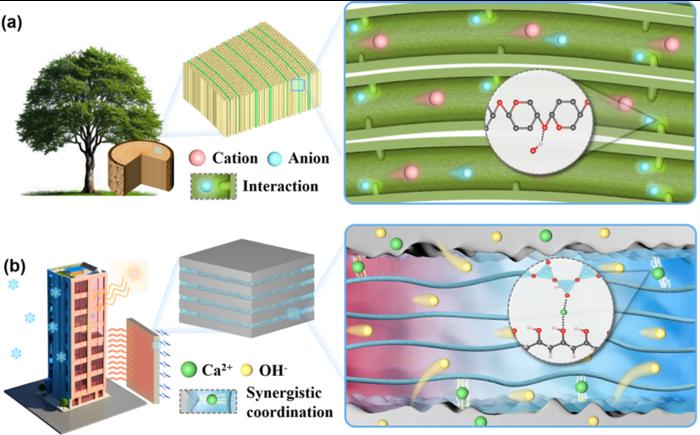
In a groundbreaking advancement reported in the latest issue of Science Bulletin, a team spearheaded by Professor Zhou Yang from Southeast University has introduced an innovative bio-inspired thermoelectric cement. This material demonstrates an exceptional Seebeck coefficient, achieved through a sophisticated process known as interfacial selective immobilization. This method not only enhances the cement’s thermoelectric properties but also marks a significant leap forward in materials science, showcasing the potential for integrating functional polymers with traditional construction materials.
The development of this thermoelectric cement-hydrogel composite stems from nature itself, mimicking the structural design of plant stems. By employing a multilayered architecture, the researchers have engineered a composite that not only excels in thermoelectric performance but also maintains structural integrity under stress. With a Seebeck coefficient measured at an impressive −40.5 mV/K, this new composite significantly outperforms existing cement-based thermoelectric materials, surpassing previous records by factors of ten and six for the Seebeck coefficient and figure of merit (ZT), respectively.
At the core of this extraordinary performance lies the interfacial selective ion immobilization technique. The hybrid architecture combines hydrogel layers that act as highways for hydroxide ions (OH−) while creating robust coordination bonds with calcium ions (Ca2+) at the cement-hydrogel interfaces. This strategic manipulation allows for the selective immobilization of ions, resulting in a pronounced disparity in diffusion rates between Ca2+ and OH−. Such selective ion transport is crucial for thermoelectric applications, where efficiency in generating electrical energy from temperature differentials is paramount.
Moreover, the engineered multilayer structure contributes not only to the thermoelectric capability but also enhances the mechanical strength and energy storage potential of the composite. This dual functionality positions the new cement-hydrogel hybrid as a versatile candidate for energy harvesting and storage systems. The ability to simultaneously capture and store energy opens up new avenues for powering electronic devices situated in smart infrastructure, including sensors and wireless communication nodes embedded within intelligent buildings or advanced pavement systems.
In practical applications, the implications of this innovative material are profound. The continuous power supply provided by the composite could significantly enhance the functionality of a variety of electronic devices, particularly in scenarios where traditional power sources are impractical or unsustainable. This advancement could pave the way for smarter cities, where infrastructure not only serves as a physical framework but also as an active participant in energy management and sustainability efforts.
The work was made possible through funding from the National Natural Science Foundation of China and the Natural Science Foundation of Jiangsu Province, indicating a strong commitment to fostering research and development in advanced material sciences. This study underscores the importance of collaborative efforts and financial investment in the pursuit of innovative solutions to contemporary challenges in energy and materials science.
In conclusion, Professor Zhou Yang and his team have succeeded in creating a bio-inspired thermoelectric cement that not only showcases remarkable properties but also embodies the marriage of nature and technology. As the research community eagerly anticipates further developments and potential real-world applications of this advanced material, it is clear that foundational shifts in the way we consider construction materials and energy harvesting technologies are on the horizon. The broader impact of such innovations could manifest in the evolution of energy-efficient buildings and infrastructure, contributing to global sustainability efforts.
The research showcases the influence of biomimicry in engineering and materials science, emphasizing how insights from nature can lead to revolutionary advancements in technology. As the scientific community begins to explore and commercialize this innovative approach to cement, the possibilities for application are nearly limitless. The journey from laboratory research to practical implementation is fraught with challenges, yet the potential rewards of integrating such advanced materials into our infrastructure are too significant to ignore.
Ultimately, the research led by Professor Yang represents a substantial leap toward realizing fully sustainable buildings capable of harnessing and storing energy from the environment. Scientists and engineers alike will undoubtedly be watching closely as this technology progresses from theoretical studies to practical applications that may redefine our understanding of construction material properties.
The fusion of biology and technology exemplified in this thermoelectric cement signifies a future where materials are not merely passive entities but active contributors to the energy landscape. With ongoing advancements in material science and engineering, we are on the cusp of a new era where innovation leads to practical solutions for some of the most pressing challenges of our time.
As we look toward the future, developments such as these highlight the importance of interdisciplinary collaboration in research. By bridging gaps between biology, chemistry, and engineering, researchers can unlock new pathways for creating sustainable materials that benefit society as a whole.
Subject of Research: Bio-inspired thermoelectric cement
Article Title: Team Develops Bio-inspired Thermoelectric Cement with High Efficiency
News Publication Date: October 2023
Web References: http://dx.doi.org/10.1016/j.scib.2025.03.032
References: Science Bulletin
Image Credits: ©Science China Press
Keywords
Bio-inspired materials, Thermoelectric cement, Energy harvesting, Multilayer composite, Sustainability, Materials science, Interfacial selective ion immobilization, Smart buildings, Innovative technology.
Tags: advanced building materials researchbio-inspired thermoelectric cementcement-hydrogel compositefunctional polymers in materials scienceinterfacial selective immobilization techniquemultilayered architecture in constructionProfessor Zhou Yang research findingsSeebeck coefficient improvementself-powered architecturestructural integrity of thermoelectric compositessustainable construction technologiesthermoelectric materials innovation





